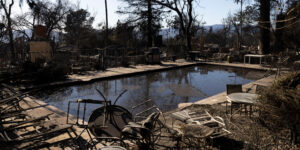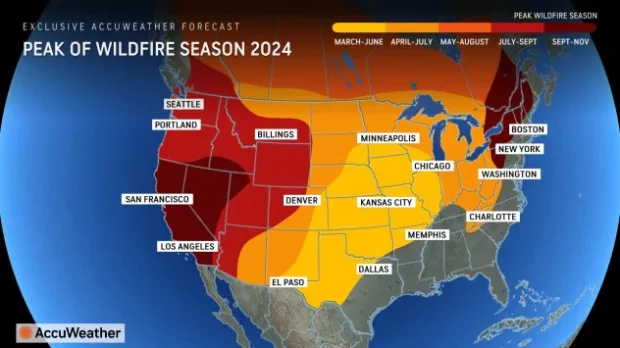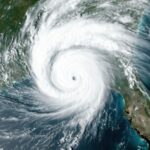The approaching wildfire season may bring hazardous air quality from blazes burning across the U.S., but it’s expected to be below the historical average in terms of the number of fires and acres burned.
AccuWeather’s forecast for the 2024 wildfire season predicts between 4 and 6 million acres of land to be burned in 2024, well below the historical average of 7 million acres.
However, fire activity is projected to be near to above average in terms of the number of fires and well above average in terms of the acreage burned across Canada. Because of this, air quality across Canada and the northern U.S. could worsen at times during the summer, affecting people outside, especially those with breathing conditions.
The Western half of the U.S. typically accounts for some of the largest wildfires across the nation. Conditions will gradually become more conducive for fires by midsummer in the Northwest and northern Rockies. Wildfire season in the regions will begin to pick up in July and persist into early autumn, according to AccuWeather.

California may benefit from a wet and stormy winter. Wildfires will likely be limited until later in the summer, with peak fire season expected from September into November, the report states.
There is still a chance of fires breaking out earlier in the year in California.
“If extended streaks of heat and dryness occur in May and June, the risk of wildfires can start earlier during the summer, increasing rapidly into the fall for more significant fires,” AccuWeather Long-Range Forecaster Paul Pastelok warned in the report. “The combination of 2023 and 2024 wet seasons will contribute to extensive growth of new fuels.”
Certain regions of the U.S. face heightened fire risk, including Texas, where a grassfire fueled by strong winds burned more than 1 million acres. That region of the Texas Panhandle and other nearby areas of the southern Plains are facing a “high to extreme risk of significant fires in 2024,” the report states.
The potential of significant fires exists in Michigan, Wisconsin, Minnesota and northwestern Ontario, due in part to weather patterns across the region dating back to late last year, according to the report.




















 First 2025 Atlantic Hurricane Season Forecasts 7 Named Storms
First 2025 Atlantic Hurricane Season Forecasts 7 Named Storms  Four P/C Insurers Are ‘AI Titans’; AI Impact Leaders Revealed: Research
Four P/C Insurers Are ‘AI Titans’; AI Impact Leaders Revealed: Research  Musk’s Massive Tesla Lithium Plant Hunts for Water in Drought-Hit Texas
Musk’s Massive Tesla Lithium Plant Hunts for Water in Drought-Hit Texas  The Resolution Solution: How to Make Your Goals More Manageable
The Resolution Solution: How to Make Your Goals More Manageable 